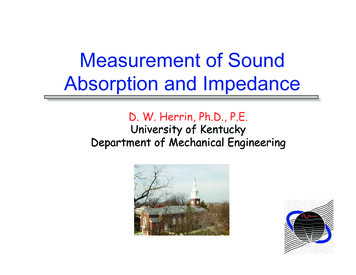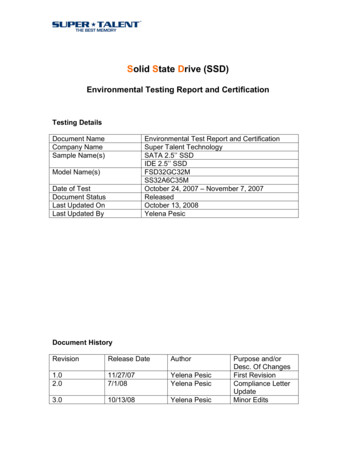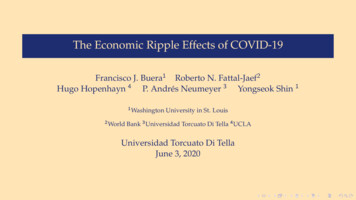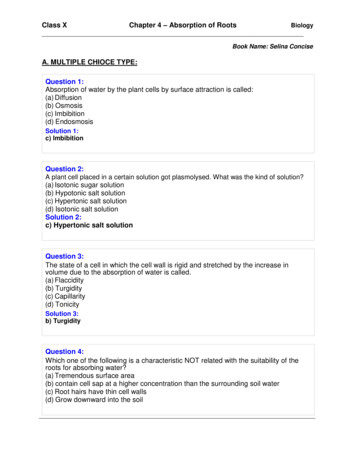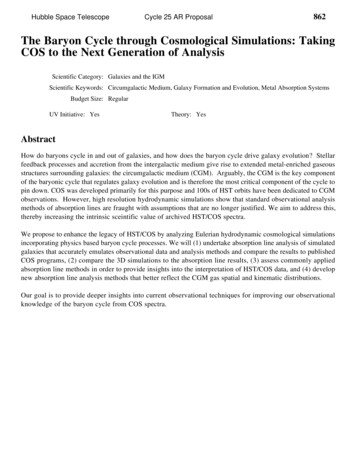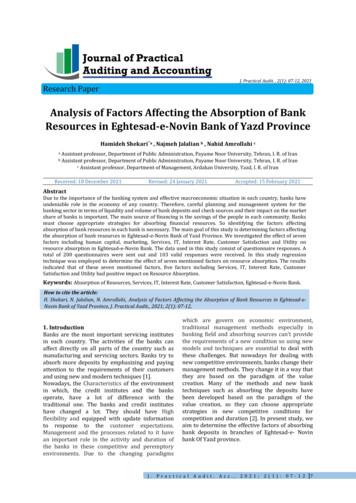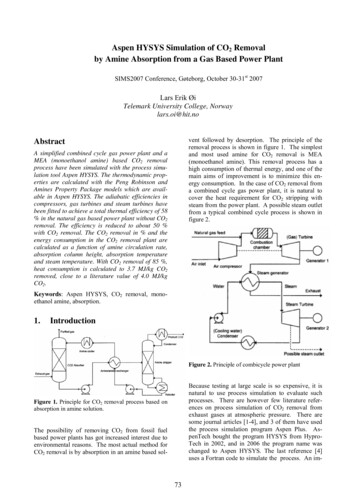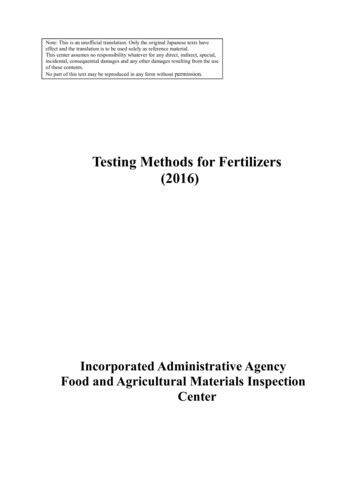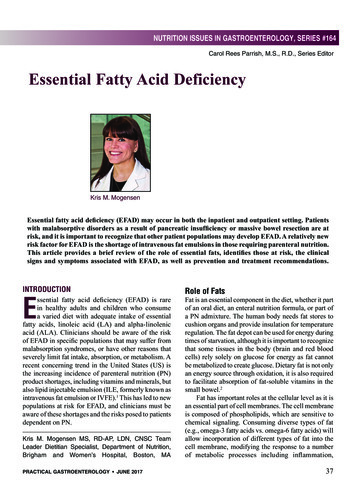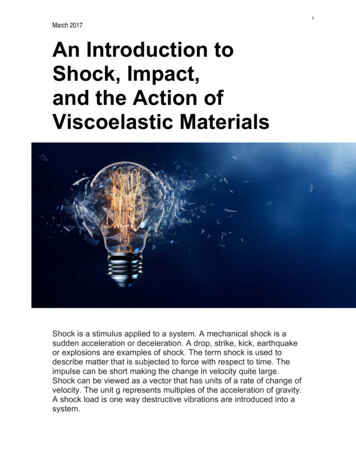
Transcription
March 2017An Introduction toShock, Impact,and the Action ofViscoelastic MaterialsShock is a stimulus applied to a system. A mechanical shock is asudden acceleration or deceleration. A drop, strike, kick, earthquakeor explosions are examples of shock. The term shock is used todescribe matter that is subjected to force with respect to time. Theimpulse can be short making the change in velocity quite large.Shock can be viewed as a vector that has units of a rate of change ofvelocity. The unit g represents multiples of the acceleration of gravity.A shock load is one way destructive vibrations are introduced into asystem.1
An impact is an extreme force or shock applied over a short time period. As whentwo or more objects collide. This type of acceleration or force has a greater effectthan a lower force applied over a longer period of time. The effect can bedevastating and depends essentially on the relative velocity of the bodies to oneanother. At customary speeds an object struck by a projectile will deform. Thedeformation works to absorb a percentage of the force applied. However, a highvelocity impact does not allow sufficient time for these deformations. The struckmaterial or object behaves as if it was more fragile, and the better part of theapplied force works toward fracturing the material.Damaging Effects of Shock and Impact ForcesPhysical (mechanical) shock can damage an entire object or a single element ofthat object. In the featured image above the entire light bulb may be destroyed byshock or just the filament within. Fracture damage occurs when two or more items impact each otheror external forces impact an object. A ductile item can be bent by impact or shock. Mechanical failure can occur with numerous repeated low-level shocks. Cumulative minor damage from several or repeated shocks will eventuallyresult in instability. Service life of a product can be shortened by shock or impact andreliability reduced. Shock can invalidate the results from precision scientific instruments Some materials such as explosives may detonate from mechanicalshock or impact Connections can be weakened or separated by shock.Based on the type of inputs present in the application – shock attenuationand impact (absorbing) components can be comprised of: mechanical shockabsorbers, linear dampers, spring isolators, elastomeric isolators, air springs orstructural damping treatments. Additionally, viscoelastic material and componentswork to isolate impact, attenuate shock and damp vibration. The geometry,thickness and durometer of the material can be engineered to meet specificdesign requirements.Viscoelastic materials exhibit both viscous (liquid) and elastic (solid)characteristics when under load. Viscous materials resist shear flow and strainlinearly (with time) under stress or load. Elastic materials strain when stretchedbut return to their original state once the stress is removed. Viscoelasticmaterials have elements of both liquid and solid properties and exhibit timedependent strain.2
Shock, Impact and Viscoelastic Materials Glossary of TermsAcceleration – a vector quantity that specifies the time rate of change of velocityAmplitude – the maximum value of a sinusoidal quantity (i.e. acceleration,displacement)Attenuation – is the gradual loss in intensity of any kind of flux through a mediumCenter of Gravity – the point of support at which a body is in balanceDamping – dissipation of energy in an oscillating system. Limits maximumamplitude at isolator natural frequencyDeflection – Is the distance an elastic body or spring moves when subjected to astatic or dynamic forceDisplacement – the change of position of a body, usually measured form themean position of rest. Displacement is related to acceleration by frequencyFoundation – is a structure that supports the gravity load of a mechanical systemFragility – the amount of shock, impact or vibration that a piece of equipment canendure. Isolation systems are designed to limit the transmission of forces to thestated fragilityFrequency – the number of times the motion repeats itself per unit of time. Theunit cycle per second is called Hertz (Hz)Hysteresis – a retardation of an effect when the forces acting upon a body arechanged as if from viscosity or internal friction. Sorbothane turns mechanicalenergy into a small amount of heat. As the material is deformed, molecular frictiongenerates heat. This “lost energy” is hysteresisIsolation – Is a reduction in the capacity of a system to respond to an excitation.Achieved by the use of a resilient element between the equipment and mountingsurfaceMass – weight in pounds divided by the gravitational constant, (g 32.2ft/sec2 or386 in/sec2)Natural Frequency – the number of cycles of oscillation that occurs in a timeperiod when moved from a normal resting position and allowed to vibrate freelyPeriodic Motion – a motion that repeats itself at definite intervals of timeShape Factor – the loaded area over the unloaded area of a shock or vibrationmount3
Shock – a condition where the equilibrium of a system is disrupted by a suddenacceleration or deceleration, or by a sudden change in the direction or magnitudeof a velocity vectorShock Absorber – a device, component or material that dissipates energy tomodify the response of a mechanical system to applied shockShock Mount or Isolator – Is a resilient support that isolates a system fromshock motion or excitationShock Pulse – primary disturbance characterized by a rise and decay ofacceleration in a relatively short timeSpring Rate/Stiffness – the force required to deflect an isolator a unit distance.Stiffness is the slope of a curve showing force on the Y-axis and deflection on theX-axis. Units typically are pounds/inchStructural Damping – reduces the vibration of resonating surfaces that radiate.Damping is accomplished by affixing a material directly to the vibratory surface.This material converts the mechanical vibration energy into to a minimal amountof heat energyTangent of Delta – a dimensionless term that expresses the out-of-phase timerelationship between a shock impact or vibration and the transmission of the forceto the support. It can also be known as tan delta, the damping coefficient, or theloss factor. The higher the tangent of delta, the better the material performancewith regards to shock and vibrationTransmissibility – percentage of vibratory force or motion transmitted to itssupportVelocity – a vector quantity that specifies the time rate of change of displacementwith respect to a reference timeViscoelastic – a material that exhibits properties of both liquids (viscoussolutions) and solids (elastic materials). Because viscoelastic behavior is useful inshock and vibration applications many materials claim to be viscoelastic.Technically, they are correct but many of these materials have only traceviscoelastic properties. A viscous material (a liquid) deforms under load andtransmits forces in all directions. It distributes a small amount of pressure over alarge area. It does not recover its shape when the load is removed. An elasticmaterial deforms under load and returns to its original shape when the load isremove4
The Unique Properties of Sorbothane Sorbothane is a solid that distorts easilyand recovers completely. It can cope withenergy in more than one direction.Sorbothane has the characteristics of bothviscous and elastic materials.A proprietary viscoelastic polyurethaneSorbothane offers engineers uniqueopportunities to attenuate shock, isolatevibrations and damp noise in mechanicalsystems. Sorbothane is a thermoset,polyether-based polyurethane solid that flowslike a liquid under load while retainingexcellent memory. Sorbothane isformulated for enhanced viscoelastic properties. Sorbothane is consistentlyeffective over a wide temperature range (-29 to 71 degrees Celsius).Viscous materials (liquids) deform under load and transmit force in all directions.They do not recover their shape when the load is removed. An elastic materialdeforms under load and returns to its original shape after the load is removed.The energy from a Sorbothane deflection is converted into a small amount ofheat, which dissipates from the material. The result is a unique system with theability to absorb shock, isolate vibration and damp unwanted noise.Because Sorbothane is a non-Newtonian material stress is not proportional tostrain and mechanical energy is “lost” by conversion to heat. The response ofSorbothane to a load is highly dependent on the rate of force application(frequency dependent responses).Sorbothane is highly damped which makes it particularly desirable for difficultapplications, which require operation near or at resonant frequencies.Sorbothane is available as custom-moldedparts, select standard shapes and sheetstock in a variety of thickness and sizes.Parts can be specified in durometers rangingfrom 30 to 80 on the Shore 00 scale.The most effective static deflection forSorbothane with a shape factor between0.3 and 1.0 is in the range of 10-20%.5
6Sorbothane Performance CurvesSorbothane turns mechanical energy into heat. As the material is deformed,molecular friction generates heat. This “lost energy” is called hysteresis. Energy istranslated perpendicularly away from the axis of incidence and its effect is pushednearly 90 out of phase from the original disturbance. This phase shift, known as“Tan Delta”, is a measure of Sorbothane’s damping effectiveness. The higher thevalue of Tan Delta, the greater the amount of damping that occurs.CONTROLLING SHOCK WITH SORBOTHANE High damping in a polymer reduces the impulse peak of a shock wave over alonger time frame. Sorbothane reduces the impact force up to 80% and bringsthe mass slowly to rest. A gradual deceleration affords better protection of delicateequipment. Sorbothane exhibits very low rebound when compared to othermaterials.
IMPACT ABSORPTION USING SORBOTHANE The graph below shows the high hysteresis necessary for efficient impactabsorption. By comparing the area under the curves, Sorbothane removes moreof the impact energy from the system. Natural rubber is more elastic and returnsenergy to the system. High-energy return causes high rebound and increases thepotential for damage.Sorbothane can decelerate parts and can reduce peak forces during suddenstops in minimal sway space. Impact absorption up to 80% is possible at properdynamic deflections.7
8Calculating Shock Response With Sorbothane
9The Sorbothane Engineering Design GuideA Windows-based program — “Design Guide” which parallels the calculationmethod can be downloaded guide.aspxThe Sorbothane Engineering Design Guide has been developed to assistengineers with a practical, hands-on approach to designing with Sorbothane material.Sorbothane, Inc. offers additional technical and engineering support.You may contact support@sorbothane.com if you have any questions.
Sorbothane, Inc. – Innovating Shock & Vibration SolutionsFor over 33 years, Sorbothane Inc. has been and will continue to bethe innovative and trusted choice of engineers worldwide for developing materialsand components that isolate vibration, attenuate shock and damp unwantednoise. Sorbothane, Inc. is located in Kent, Ohio, right in the middle of the polymercapital of America. With 64,000 square feet of manufacturing space and a seriesof specialized custom built pouring machines the Sorbothane team stands readyto meet any requirement. Sorbothane, Inc. has engineering design staff andproduction teams that specialize in providing shock and vibration solutions thatmeet and exceed expectations. In-house testing, a quality assurance lab andefficient distribution place an emphasis on accuracy, quality and customersatisfaction.Markets ServedTRANSPORTATION SHIPPING & LOGISTICSSorbothane SAFEGUARDS PRECIOUS CARGOPRECISION LABORATORY EQUIPMENTSorbothane ISOLATES DISRUPTIVE VIBRATIONMOBILE ELECTRONIC DEVICESSorbothane ATTENUATES IMPACT SHOCK & ISOLATES VIBRATIONCONSUMER & COMMERCIAL PRODUCTSSorbothane DAMPS UNWANTED NOISE & VIBRATIONINDUSTRIAL MANUFACTURING EQUIPMENTSorbothane EXTENDS EQUIPMENT LIFEAEROSPACE & AERONAUTICALSorbothane PROTECTS CRITICAL COMPONENTSMEDICAL EQUIPMENTSorbothane GUARDS PERFORMANCESPORTING GOODS & FITNESSSorbothane PROTECTS, CUSHIONS & COMFORTSSorbothane, Inc.2144 State Route 59 - Kent, Ohio .comSorbothane — Innovating Shock andVibration Solutions10
Sorbothane, Inc. - Innovating Shock & Vibration Solutions For over 33 years, Sorbothane Inc. has been and will continue to be the innovative and trusted choice of engineers worldwide for developing materials and components that isolate vibration, attenuate shock and damp unwanted noise.
